Analysis of Home Foods: Organisational Management Report
VerifiedAdded on 2021/02/21
|9
|2883
|30
Report
AI Summary
This report provides an in-depth analysis of Home Foods (HF), a Manchester-based company supplying raw materials and packaging to fast-food outlets. The report begins by defining organisational management and its importance, followed by an examination of HF's business functions. It focuses on Human Resource Management (HRM) and customer service, detailing their aims, objectives, and contributions to the company's success. The HRM section explores strategies for employee satisfaction, organisational structure design, and inter-departmental coordination. The customer service section highlights the importance of customer satisfaction, loyalty, and experience, as well as the role of effective communication. The report then evaluates the effectiveness of HF's hierarchical organisational structure, highlighting its role in delegation, customer service improvement, decision-making, and communication. Overall, the report demonstrates how effective organisational management contributes to HF's growth and competitive advantage.
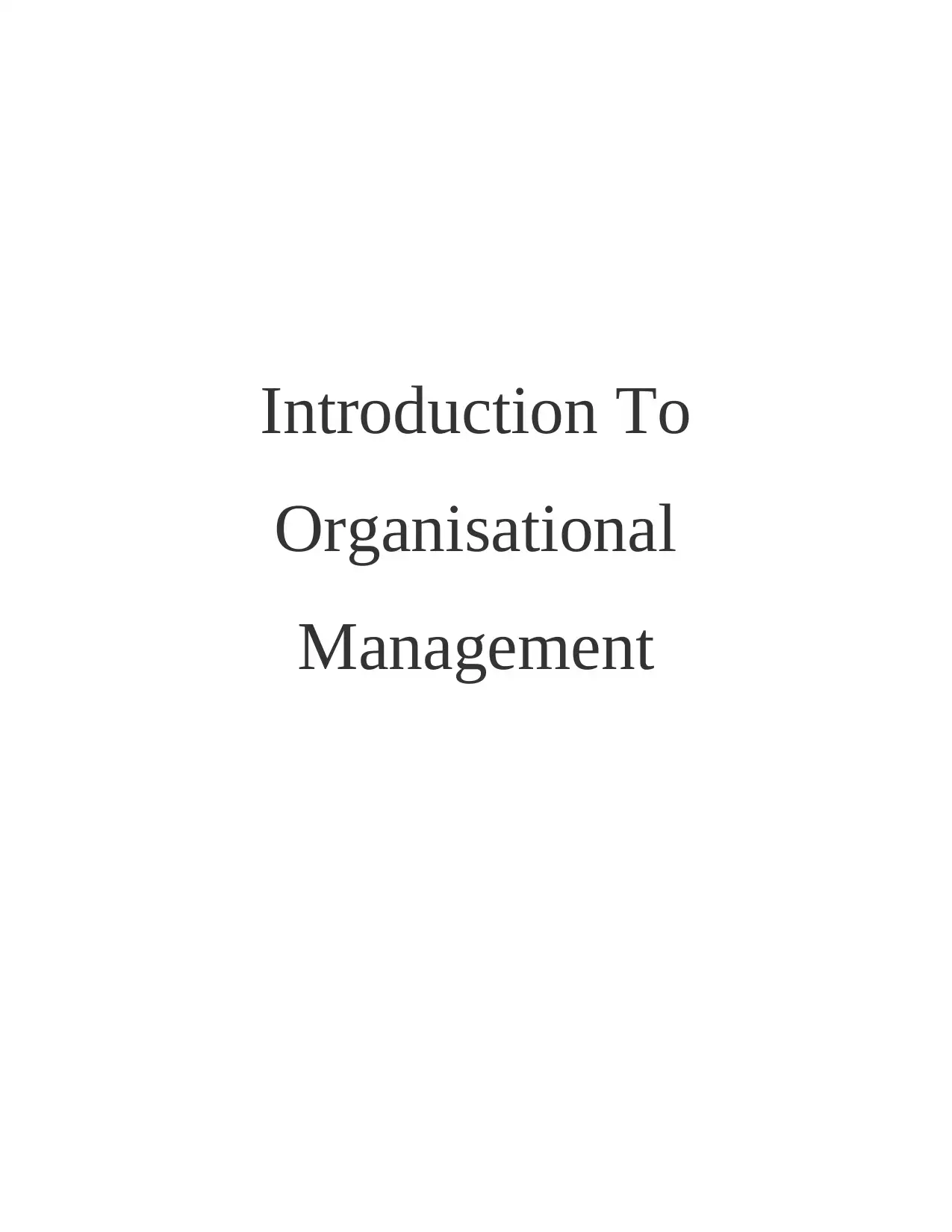
Introduction To
Organisational
Management
Organisational
Management
Paraphrase This Document
Need a fresh take? Get an instant paraphrase of this document with our AI Paraphraser
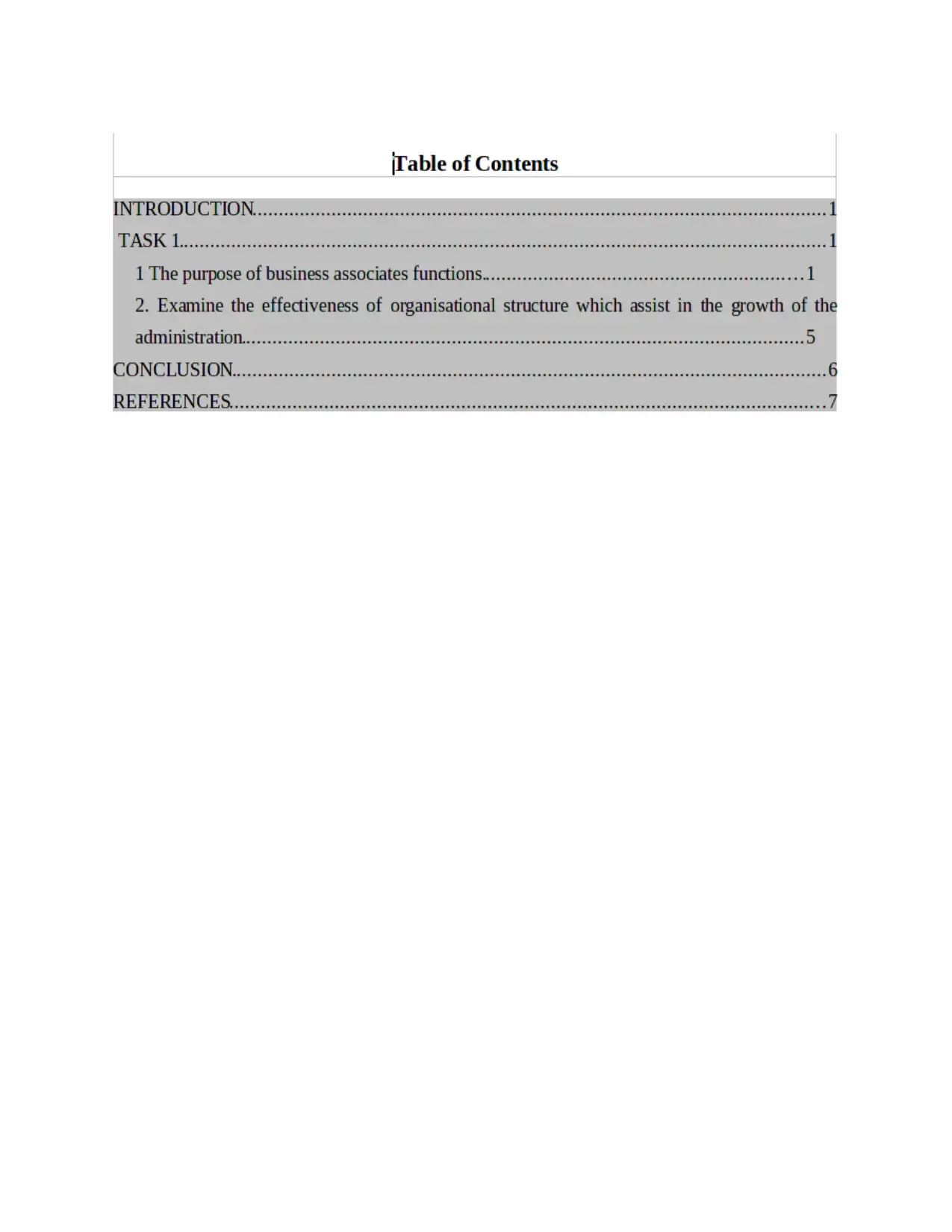
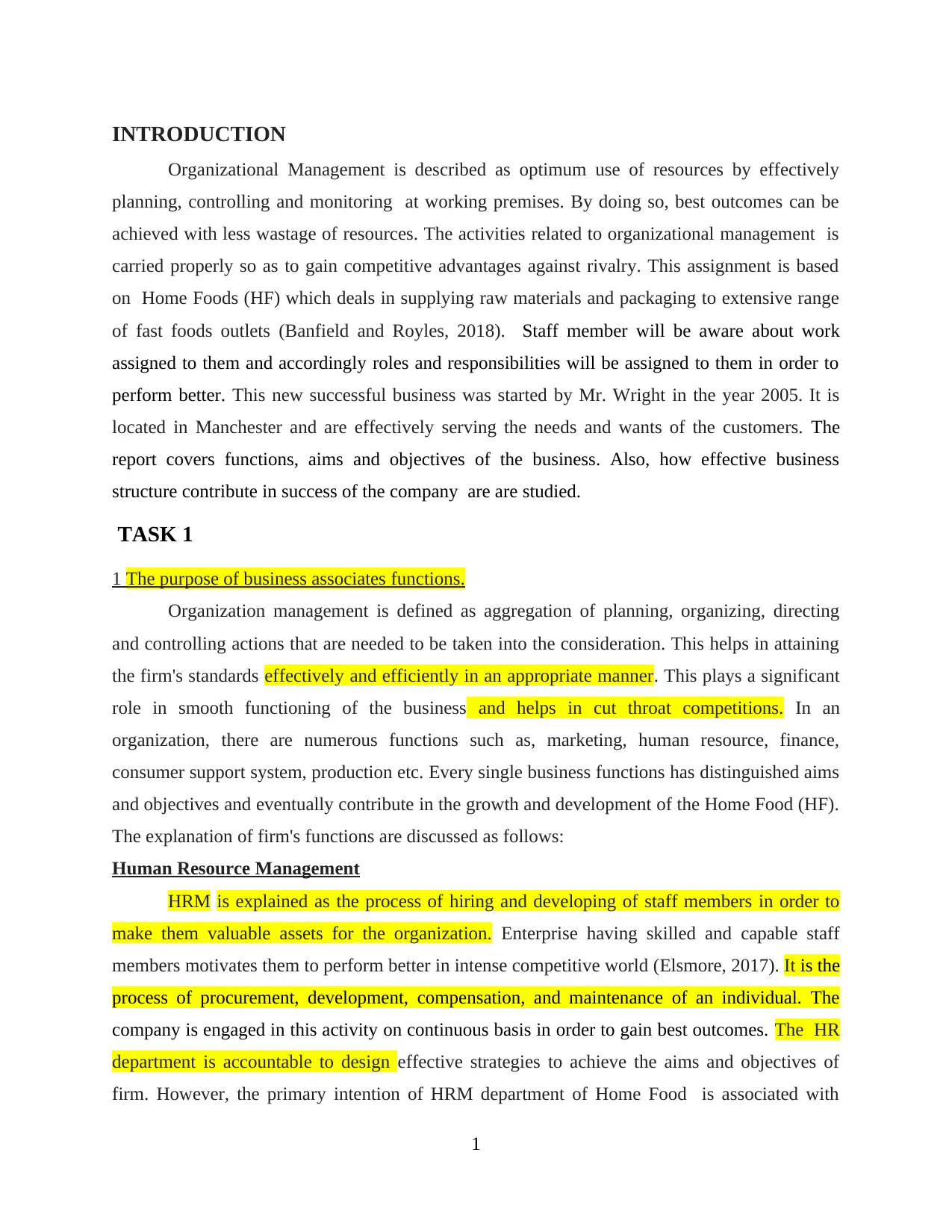
INTRODUCTION
Organizational Management is described as optimum use of resources by effectively
planning, controlling and monitoring at working premises. By doing so, best outcomes can be
achieved with less wastage of resources. The activities related to organizational management is
carried properly so as to gain competitive advantages against rivalry. This assignment is based
on Home Foods (HF) which deals in supplying raw materials and packaging to extensive range
of fast foods outlets (Banfield and Royles, 2018). Staff member will be aware about work
assigned to them and accordingly roles and responsibilities will be assigned to them in order to
perform better. This new successful business was started by Mr. Wright in the year 2005. It is
located in Manchester and are effectively serving the needs and wants of the customers. The
report covers functions, aims and objectives of the business. Also, how effective business
structure contribute in success of the company are are studied.
TASK 1
1 The purpose of business associates functions.
Organization management is defined as aggregation of planning, organizing, directing
and controlling actions that are needed to be taken into the consideration. This helps in attaining
the firm's standards effectively and efficiently in an appropriate manner. This plays a significant
role in smooth functioning of the business and helps in cut throat competitions. In an
organization, there are numerous functions such as, marketing, human resource, finance,
consumer support system, production etc. Every single business functions has distinguished aims
and objectives and eventually contribute in the growth and development of the Home Food (HF).
The explanation of firm's functions are discussed as follows:
Human Resource Management
HRM is explained as the process of hiring and developing of staff members in order to
make them valuable assets for the organization. Enterprise having skilled and capable staff
members motivates them to perform better in intense competitive world (Elsmore, 2017). It is the
process of procurement, development, compensation, and maintenance of an individual. The
company is engaged in this activity on continuous basis in order to gain best outcomes. The HR
department is accountable to design effective strategies to achieve the aims and objectives of
firm. However, the primary intention of HRM department of Home Food is associated with
1
Organizational Management is described as optimum use of resources by effectively
planning, controlling and monitoring at working premises. By doing so, best outcomes can be
achieved with less wastage of resources. The activities related to organizational management is
carried properly so as to gain competitive advantages against rivalry. This assignment is based
on Home Foods (HF) which deals in supplying raw materials and packaging to extensive range
of fast foods outlets (Banfield and Royles, 2018). Staff member will be aware about work
assigned to them and accordingly roles and responsibilities will be assigned to them in order to
perform better. This new successful business was started by Mr. Wright in the year 2005. It is
located in Manchester and are effectively serving the needs and wants of the customers. The
report covers functions, aims and objectives of the business. Also, how effective business
structure contribute in success of the company are are studied.
TASK 1
1 The purpose of business associates functions.
Organization management is defined as aggregation of planning, organizing, directing
and controlling actions that are needed to be taken into the consideration. This helps in attaining
the firm's standards effectively and efficiently in an appropriate manner. This plays a significant
role in smooth functioning of the business and helps in cut throat competitions. In an
organization, there are numerous functions such as, marketing, human resource, finance,
consumer support system, production etc. Every single business functions has distinguished aims
and objectives and eventually contribute in the growth and development of the Home Food (HF).
The explanation of firm's functions are discussed as follows:
Human Resource Management
HRM is explained as the process of hiring and developing of staff members in order to
make them valuable assets for the organization. Enterprise having skilled and capable staff
members motivates them to perform better in intense competitive world (Elsmore, 2017). It is the
process of procurement, development, compensation, and maintenance of an individual. The
company is engaged in this activity on continuous basis in order to gain best outcomes. The HR
department is accountable to design effective strategies to achieve the aims and objectives of
firm. However, the primary intention of HRM department of Home Food is associated with
1
⊘ This is a preview!⊘
Do you want full access?
Subscribe today to unlock all pages.

Trusted by 1+ million students worldwide
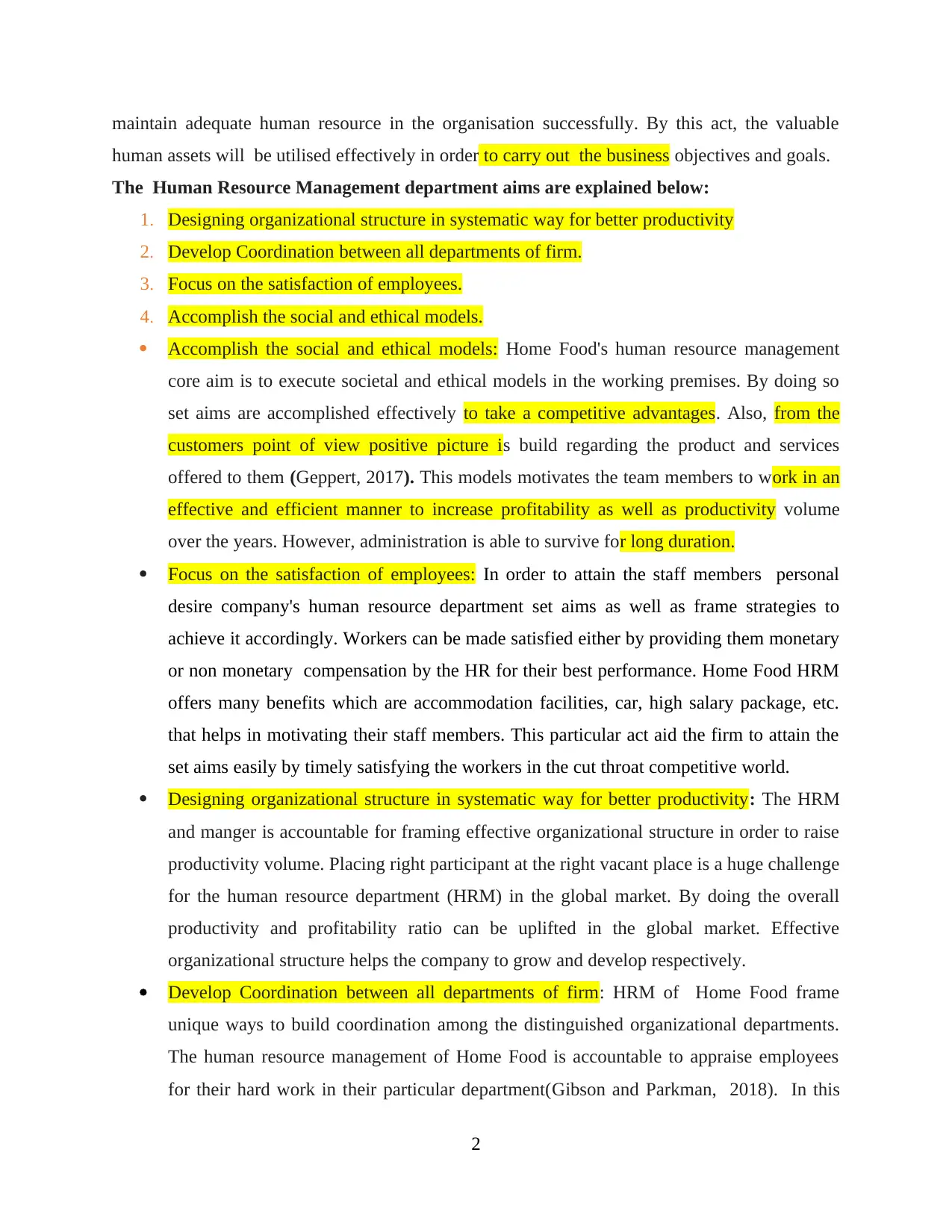
maintain adequate human resource in the organisation successfully. By this act, the valuable
human assets will be utilised effectively in order to carry out the business objectives and goals.
The Human Resource Management department aims are explained below:
1. Designing organizational structure in systematic way for better productivity
2. Develop Coordination between all departments of firm.
3. Focus on the satisfaction of employees.
4. Accomplish the social and ethical models.
Accomplish the social and ethical models: Home Food's human resource management
core aim is to execute societal and ethical models in the working premises. By doing so
set aims are accomplished effectively to take a competitive advantages. Also, from the
customers point of view positive picture is build regarding the product and services
offered to them (Geppert, 2017). This models motivates the team members to work in an
effective and efficient manner to increase profitability as well as productivity volume
over the years. However, administration is able to survive for long duration.
Focus on the satisfaction of employees: In order to attain the staff members personal
desire company's human resource department set aims as well as frame strategies to
achieve it accordingly. Workers can be made satisfied either by providing them monetary
or non monetary compensation by the HR for their best performance. Home Food HRM
offers many benefits which are accommodation facilities, car, high salary package, etc.
that helps in motivating their staff members. This particular act aid the firm to attain the
set aims easily by timely satisfying the workers in the cut throat competitive world.
Designing organizational structure in systematic way for better productivity: The HRM
and manger is accountable for framing effective organizational structure in order to raise
productivity volume. Placing right participant at the right vacant place is a huge challenge
for the human resource department (HRM) in the global market. By doing the overall
productivity and profitability ratio can be uplifted in the global market. Effective
organizational structure helps the company to grow and develop respectively.
Develop Coordination between all departments of firm: HRM of Home Food frame
unique ways to build coordination among the distinguished organizational departments.
The human resource management of Home Food is accountable to appraise employees
for their hard work in their particular department(Gibson and Parkman, 2018). In this
2
human assets will be utilised effectively in order to carry out the business objectives and goals.
The Human Resource Management department aims are explained below:
1. Designing organizational structure in systematic way for better productivity
2. Develop Coordination between all departments of firm.
3. Focus on the satisfaction of employees.
4. Accomplish the social and ethical models.
Accomplish the social and ethical models: Home Food's human resource management
core aim is to execute societal and ethical models in the working premises. By doing so
set aims are accomplished effectively to take a competitive advantages. Also, from the
customers point of view positive picture is build regarding the product and services
offered to them (Geppert, 2017). This models motivates the team members to work in an
effective and efficient manner to increase profitability as well as productivity volume
over the years. However, administration is able to survive for long duration.
Focus on the satisfaction of employees: In order to attain the staff members personal
desire company's human resource department set aims as well as frame strategies to
achieve it accordingly. Workers can be made satisfied either by providing them monetary
or non monetary compensation by the HR for their best performance. Home Food HRM
offers many benefits which are accommodation facilities, car, high salary package, etc.
that helps in motivating their staff members. This particular act aid the firm to attain the
set aims easily by timely satisfying the workers in the cut throat competitive world.
Designing organizational structure in systematic way for better productivity: The HRM
and manger is accountable for framing effective organizational structure in order to raise
productivity volume. Placing right participant at the right vacant place is a huge challenge
for the human resource department (HRM) in the global market. By doing the overall
productivity and profitability ratio can be uplifted in the global market. Effective
organizational structure helps the company to grow and develop respectively.
Develop Coordination between all departments of firm: HRM of Home Food frame
unique ways to build coordination among the distinguished organizational departments.
The human resource management of Home Food is accountable to appraise employees
for their hard work in their particular department(Gibson and Parkman, 2018). In this
2
Paraphrase This Document
Need a fresh take? Get an instant paraphrase of this document with our AI Paraphraser
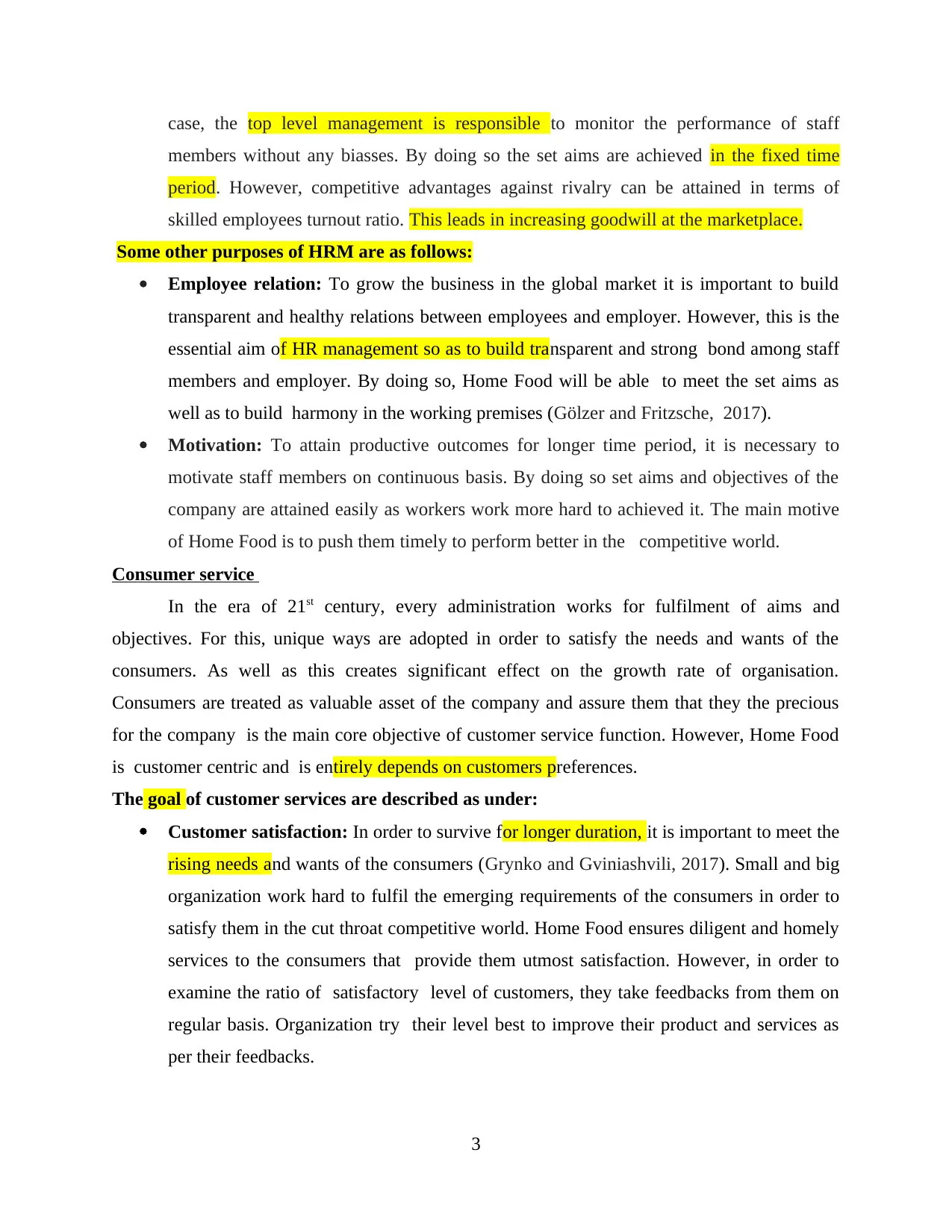
case, the top level management is responsible to monitor the performance of staff
members without any biasses. By doing so the set aims are achieved in the fixed time
period. However, competitive advantages against rivalry can be attained in terms of
skilled employees turnout ratio. This leads in increasing goodwill at the marketplace.
Some other purposes of HRM are as follows:
Employee relation: To grow the business in the global market it is important to build
transparent and healthy relations between employees and employer. However, this is the
essential aim of HR management so as to build transparent and strong bond among staff
members and employer. By doing so, Home Food will be able to meet the set aims as
well as to build harmony in the working premises (Gölzer and Fritzsche, 2017).
Motivation: To attain productive outcomes for longer time period, it is necessary to
motivate staff members on continuous basis. By doing so set aims and objectives of the
company are attained easily as workers work more hard to achieved it. The main motive
of Home Food is to push them timely to perform better in the competitive world.
Consumer service
In the era of 21st century, every administration works for fulfilment of aims and
objectives. For this, unique ways are adopted in order to satisfy the needs and wants of the
consumers. As well as this creates significant effect on the growth rate of organisation.
Consumers are treated as valuable asset of the company and assure them that they the precious
for the company is the main core objective of customer service function. However, Home Food
is customer centric and is entirely depends on customers preferences.
The goal of customer services are described as under:
Customer satisfaction: In order to survive for longer duration, it is important to meet the
rising needs and wants of the consumers (Grynko and Gviniashvili, 2017). Small and big
organization work hard to fulfil the emerging requirements of the consumers in order to
satisfy them in the cut throat competitive world. Home Food ensures diligent and homely
services to the consumers that provide them utmost satisfaction. However, in order to
examine the ratio of satisfactory level of customers, they take feedbacks from them on
regular basis. Organization try their level best to improve their product and services as
per their feedbacks.
3
members without any biasses. By doing so the set aims are achieved in the fixed time
period. However, competitive advantages against rivalry can be attained in terms of
skilled employees turnout ratio. This leads in increasing goodwill at the marketplace.
Some other purposes of HRM are as follows:
Employee relation: To grow the business in the global market it is important to build
transparent and healthy relations between employees and employer. However, this is the
essential aim of HR management so as to build transparent and strong bond among staff
members and employer. By doing so, Home Food will be able to meet the set aims as
well as to build harmony in the working premises (Gölzer and Fritzsche, 2017).
Motivation: To attain productive outcomes for longer time period, it is necessary to
motivate staff members on continuous basis. By doing so set aims and objectives of the
company are attained easily as workers work more hard to achieved it. The main motive
of Home Food is to push them timely to perform better in the competitive world.
Consumer service
In the era of 21st century, every administration works for fulfilment of aims and
objectives. For this, unique ways are adopted in order to satisfy the needs and wants of the
consumers. As well as this creates significant effect on the growth rate of organisation.
Consumers are treated as valuable asset of the company and assure them that they the precious
for the company is the main core objective of customer service function. However, Home Food
is customer centric and is entirely depends on customers preferences.
The goal of customer services are described as under:
Customer satisfaction: In order to survive for longer duration, it is important to meet the
rising needs and wants of the consumers (Grynko and Gviniashvili, 2017). Small and big
organization work hard to fulfil the emerging requirements of the consumers in order to
satisfy them in the cut throat competitive world. Home Food ensures diligent and homely
services to the consumers that provide them utmost satisfaction. However, in order to
examine the ratio of satisfactory level of customers, they take feedbacks from them on
regular basis. Organization try their level best to improve their product and services as
per their feedbacks.
3
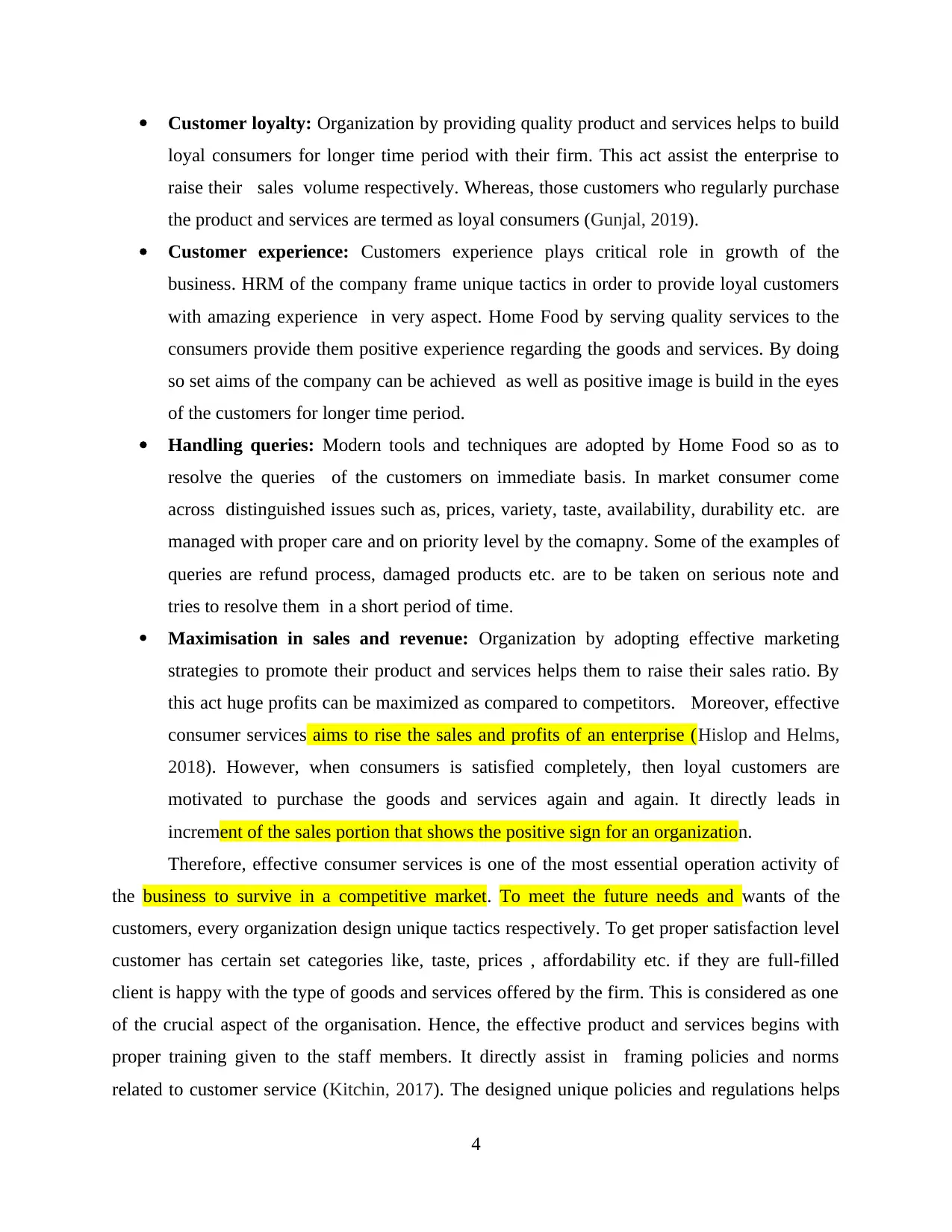
Customer loyalty: Organization by providing quality product and services helps to build
loyal consumers for longer time period with their firm. This act assist the enterprise to
raise their sales volume respectively. Whereas, those customers who regularly purchase
the product and services are termed as loyal consumers (Gunjal, 2019).
Customer experience: Customers experience plays critical role in growth of the
business. HRM of the company frame unique tactics in order to provide loyal customers
with amazing experience in very aspect. Home Food by serving quality services to the
consumers provide them positive experience regarding the goods and services. By doing
so set aims of the company can be achieved as well as positive image is build in the eyes
of the customers for longer time period.
Handling queries: Modern tools and techniques are adopted by Home Food so as to
resolve the queries of the customers on immediate basis. In market consumer come
across distinguished issues such as, prices, variety, taste, availability, durability etc. are
managed with proper care and on priority level by the comapny. Some of the examples of
queries are refund process, damaged products etc. are to be taken on serious note and
tries to resolve them in a short period of time.
Maximisation in sales and revenue: Organization by adopting effective marketing
strategies to promote their product and services helps them to raise their sales ratio. By
this act huge profits can be maximized as compared to competitors. Moreover, effective
consumer services aims to rise the sales and profits of an enterprise (Hislop and Helms,
2018). However, when consumers is satisfied completely, then loyal customers are
motivated to purchase the goods and services again and again. It directly leads in
increment of the sales portion that shows the positive sign for an organization.
Therefore, effective consumer services is one of the most essential operation activity of
the business to survive in a competitive market. To meet the future needs and wants of the
customers, every organization design unique tactics respectively. To get proper satisfaction level
customer has certain set categories like, taste, prices , affordability etc. if they are full-filled
client is happy with the type of goods and services offered by the firm. This is considered as one
of the crucial aspect of the organisation. Hence, the effective product and services begins with
proper training given to the staff members. It directly assist in framing policies and norms
related to customer service (Kitchin, 2017). The designed unique policies and regulations helps
4
loyal consumers for longer time period with their firm. This act assist the enterprise to
raise their sales volume respectively. Whereas, those customers who regularly purchase
the product and services are termed as loyal consumers (Gunjal, 2019).
Customer experience: Customers experience plays critical role in growth of the
business. HRM of the company frame unique tactics in order to provide loyal customers
with amazing experience in very aspect. Home Food by serving quality services to the
consumers provide them positive experience regarding the goods and services. By doing
so set aims of the company can be achieved as well as positive image is build in the eyes
of the customers for longer time period.
Handling queries: Modern tools and techniques are adopted by Home Food so as to
resolve the queries of the customers on immediate basis. In market consumer come
across distinguished issues such as, prices, variety, taste, availability, durability etc. are
managed with proper care and on priority level by the comapny. Some of the examples of
queries are refund process, damaged products etc. are to be taken on serious note and
tries to resolve them in a short period of time.
Maximisation in sales and revenue: Organization by adopting effective marketing
strategies to promote their product and services helps them to raise their sales ratio. By
this act huge profits can be maximized as compared to competitors. Moreover, effective
consumer services aims to rise the sales and profits of an enterprise (Hislop and Helms,
2018). However, when consumers is satisfied completely, then loyal customers are
motivated to purchase the goods and services again and again. It directly leads in
increment of the sales portion that shows the positive sign for an organization.
Therefore, effective consumer services is one of the most essential operation activity of
the business to survive in a competitive market. To meet the future needs and wants of the
customers, every organization design unique tactics respectively. To get proper satisfaction level
customer has certain set categories like, taste, prices , affordability etc. if they are full-filled
client is happy with the type of goods and services offered by the firm. This is considered as one
of the crucial aspect of the organisation. Hence, the effective product and services begins with
proper training given to the staff members. It directly assist in framing policies and norms
related to customer service (Kitchin, 2017). The designed unique policies and regulations helps
4
⊘ This is a preview!⊘
Do you want full access?
Subscribe today to unlock all pages.

Trusted by 1+ million students worldwide
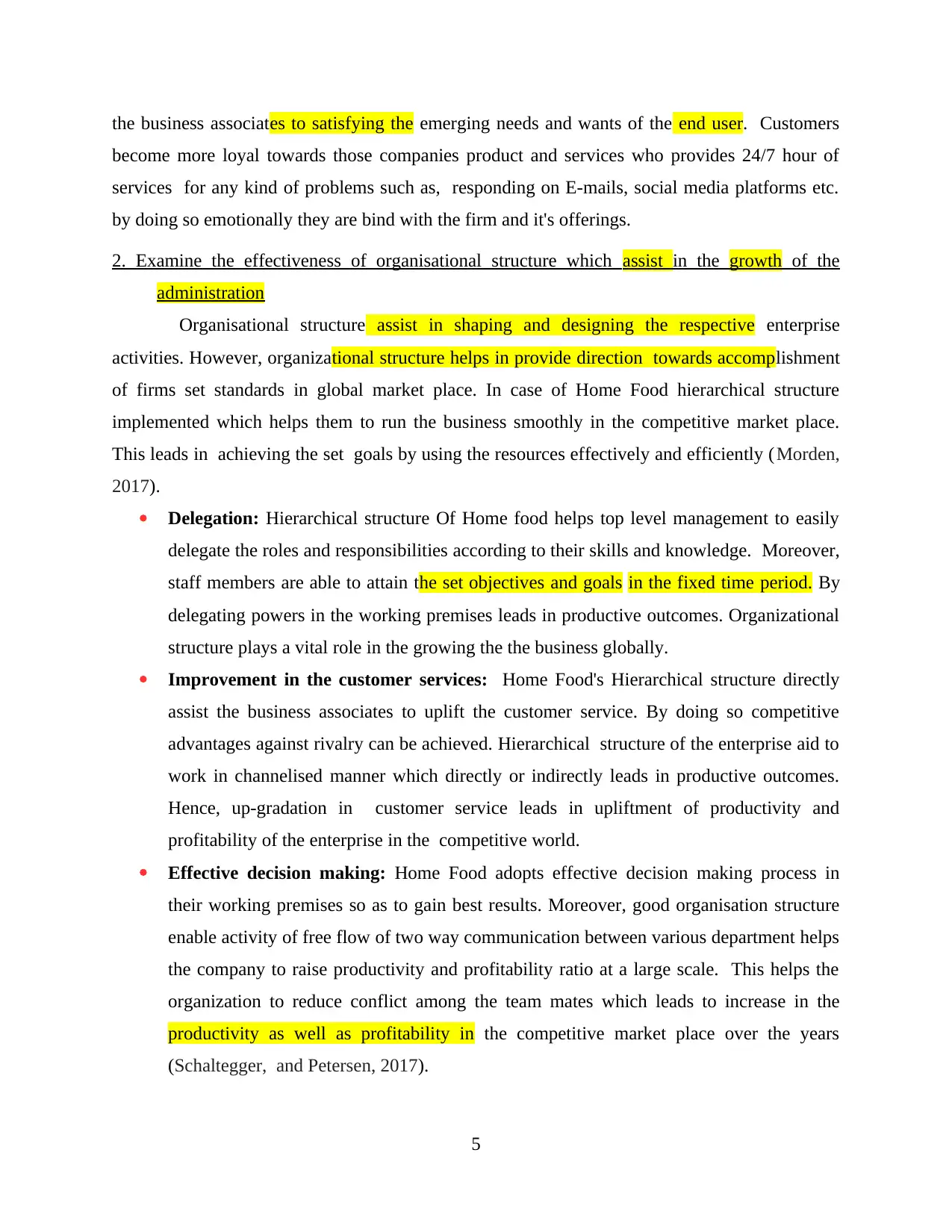
the business associates to satisfying the emerging needs and wants of the end user. Customers
become more loyal towards those companies product and services who provides 24/7 hour of
services for any kind of problems such as, responding on E-mails, social media platforms etc.
by doing so emotionally they are bind with the firm and it's offerings.
2. Examine the effectiveness of organisational structure which assist in the growth of the
administration
Organisational structure assist in shaping and designing the respective enterprise
activities. However, organizational structure helps in provide direction towards accomplishment
of firms set standards in global market place. In case of Home Food hierarchical structure
implemented which helps them to run the business smoothly in the competitive market place.
This leads in achieving the set goals by using the resources effectively and efficiently (Morden,
2017).
Delegation: Hierarchical structure Of Home food helps top level management to easily
delegate the roles and responsibilities according to their skills and knowledge. Moreover,
staff members are able to attain the set objectives and goals in the fixed time period. By
delegating powers in the working premises leads in productive outcomes. Organizational
structure plays a vital role in the growing the the business globally.
Improvement in the customer services: Home Food's Hierarchical structure directly
assist the business associates to uplift the customer service. By doing so competitive
advantages against rivalry can be achieved. Hierarchical structure of the enterprise aid to
work in channelised manner which directly or indirectly leads in productive outcomes.
Hence, up-gradation in customer service leads in upliftment of productivity and
profitability of the enterprise in the competitive world.
Effective decision making: Home Food adopts effective decision making process in
their working premises so as to gain best results. Moreover, good organisation structure
enable activity of free flow of two way communication between various department helps
the company to raise productivity and profitability ratio at a large scale. This helps the
organization to reduce conflict among the team mates which leads to increase in the
productivity as well as profitability in the competitive market place over the years
(Schaltegger, and Petersen, 2017).
5
become more loyal towards those companies product and services who provides 24/7 hour of
services for any kind of problems such as, responding on E-mails, social media platforms etc.
by doing so emotionally they are bind with the firm and it's offerings.
2. Examine the effectiveness of organisational structure which assist in the growth of the
administration
Organisational structure assist in shaping and designing the respective enterprise
activities. However, organizational structure helps in provide direction towards accomplishment
of firms set standards in global market place. In case of Home Food hierarchical structure
implemented which helps them to run the business smoothly in the competitive market place.
This leads in achieving the set goals by using the resources effectively and efficiently (Morden,
2017).
Delegation: Hierarchical structure Of Home food helps top level management to easily
delegate the roles and responsibilities according to their skills and knowledge. Moreover,
staff members are able to attain the set objectives and goals in the fixed time period. By
delegating powers in the working premises leads in productive outcomes. Organizational
structure plays a vital role in the growing the the business globally.
Improvement in the customer services: Home Food's Hierarchical structure directly
assist the business associates to uplift the customer service. By doing so competitive
advantages against rivalry can be achieved. Hierarchical structure of the enterprise aid to
work in channelised manner which directly or indirectly leads in productive outcomes.
Hence, up-gradation in customer service leads in upliftment of productivity and
profitability of the enterprise in the competitive world.
Effective decision making: Home Food adopts effective decision making process in
their working premises so as to gain best results. Moreover, good organisation structure
enable activity of free flow of two way communication between various department helps
the company to raise productivity and profitability ratio at a large scale. This helps the
organization to reduce conflict among the team mates which leads to increase in the
productivity as well as profitability in the competitive market place over the years
(Schaltegger, and Petersen, 2017).
5
Paraphrase This Document
Need a fresh take? Get an instant paraphrase of this document with our AI Paraphraser
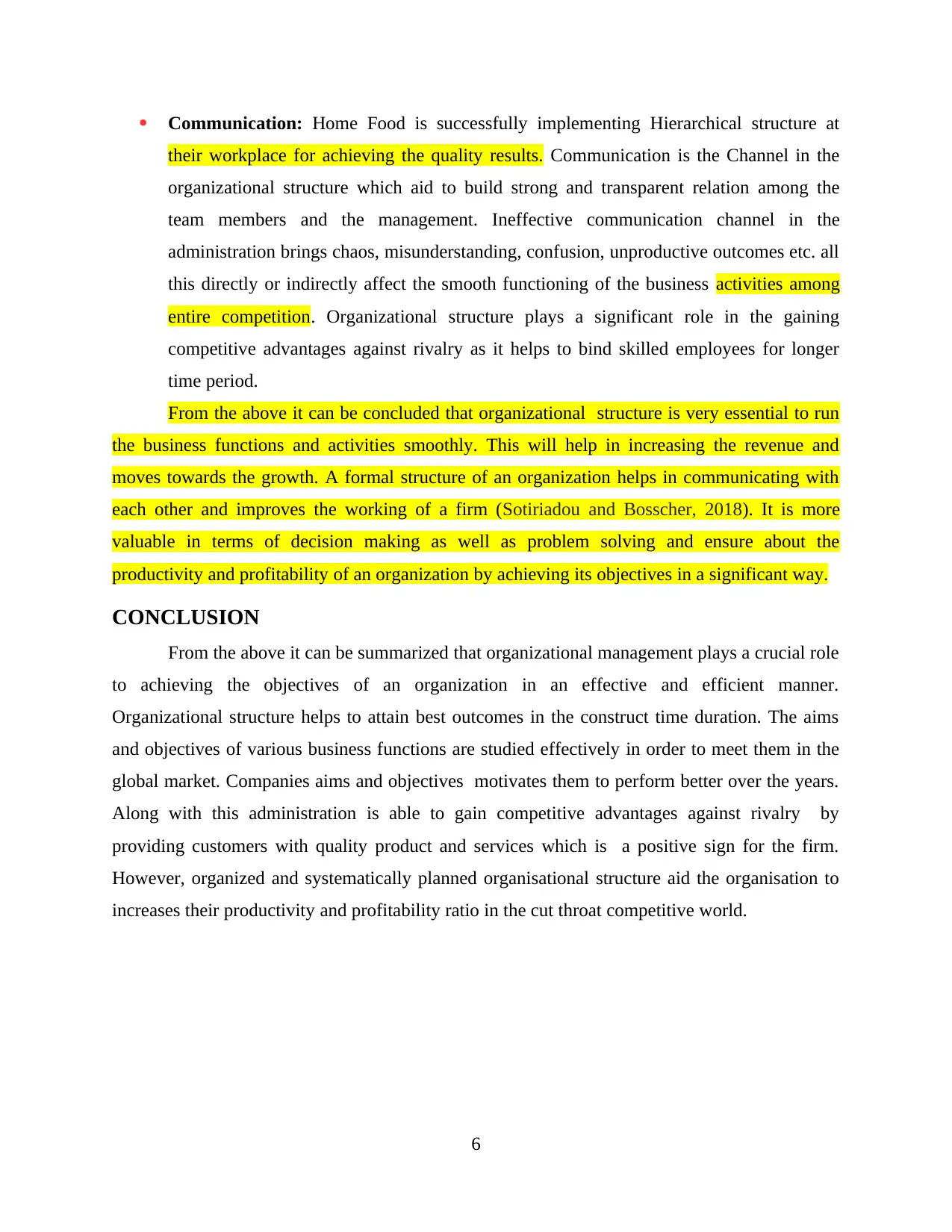
Communication: Home Food is successfully implementing Hierarchical structure at
their workplace for achieving the quality results. Communication is the Channel in the
organizational structure which aid to build strong and transparent relation among the
team members and the management. Ineffective communication channel in the
administration brings chaos, misunderstanding, confusion, unproductive outcomes etc. all
this directly or indirectly affect the smooth functioning of the business activities among
entire competition. Organizational structure plays a significant role in the gaining
competitive advantages against rivalry as it helps to bind skilled employees for longer
time period.
From the above it can be concluded that organizational structure is very essential to run
the business functions and activities smoothly. This will help in increasing the revenue and
moves towards the growth. A formal structure of an organization helps in communicating with
each other and improves the working of a firm (Sotiriadou and Bosscher, 2018). It is more
valuable in terms of decision making as well as problem solving and ensure about the
productivity and profitability of an organization by achieving its objectives in a significant way.
CONCLUSION
From the above it can be summarized that organizational management plays a crucial role
to achieving the objectives of an organization in an effective and efficient manner.
Organizational structure helps to attain best outcomes in the construct time duration. The aims
and objectives of various business functions are studied effectively in order to meet them in the
global market. Companies aims and objectives motivates them to perform better over the years.
Along with this administration is able to gain competitive advantages against rivalry by
providing customers with quality product and services which is a positive sign for the firm.
However, organized and systematically planned organisational structure aid the organisation to
increases their productivity and profitability ratio in the cut throat competitive world.
6
their workplace for achieving the quality results. Communication is the Channel in the
organizational structure which aid to build strong and transparent relation among the
team members and the management. Ineffective communication channel in the
administration brings chaos, misunderstanding, confusion, unproductive outcomes etc. all
this directly or indirectly affect the smooth functioning of the business activities among
entire competition. Organizational structure plays a significant role in the gaining
competitive advantages against rivalry as it helps to bind skilled employees for longer
time period.
From the above it can be concluded that organizational structure is very essential to run
the business functions and activities smoothly. This will help in increasing the revenue and
moves towards the growth. A formal structure of an organization helps in communicating with
each other and improves the working of a firm (Sotiriadou and Bosscher, 2018). It is more
valuable in terms of decision making as well as problem solving and ensure about the
productivity and profitability of an organization by achieving its objectives in a significant way.
CONCLUSION
From the above it can be summarized that organizational management plays a crucial role
to achieving the objectives of an organization in an effective and efficient manner.
Organizational structure helps to attain best outcomes in the construct time duration. The aims
and objectives of various business functions are studied effectively in order to meet them in the
global market. Companies aims and objectives motivates them to perform better over the years.
Along with this administration is able to gain competitive advantages against rivalry by
providing customers with quality product and services which is a positive sign for the firm.
However, organized and systematically planned organisational structure aid the organisation to
increases their productivity and profitability ratio in the cut throat competitive world.
6
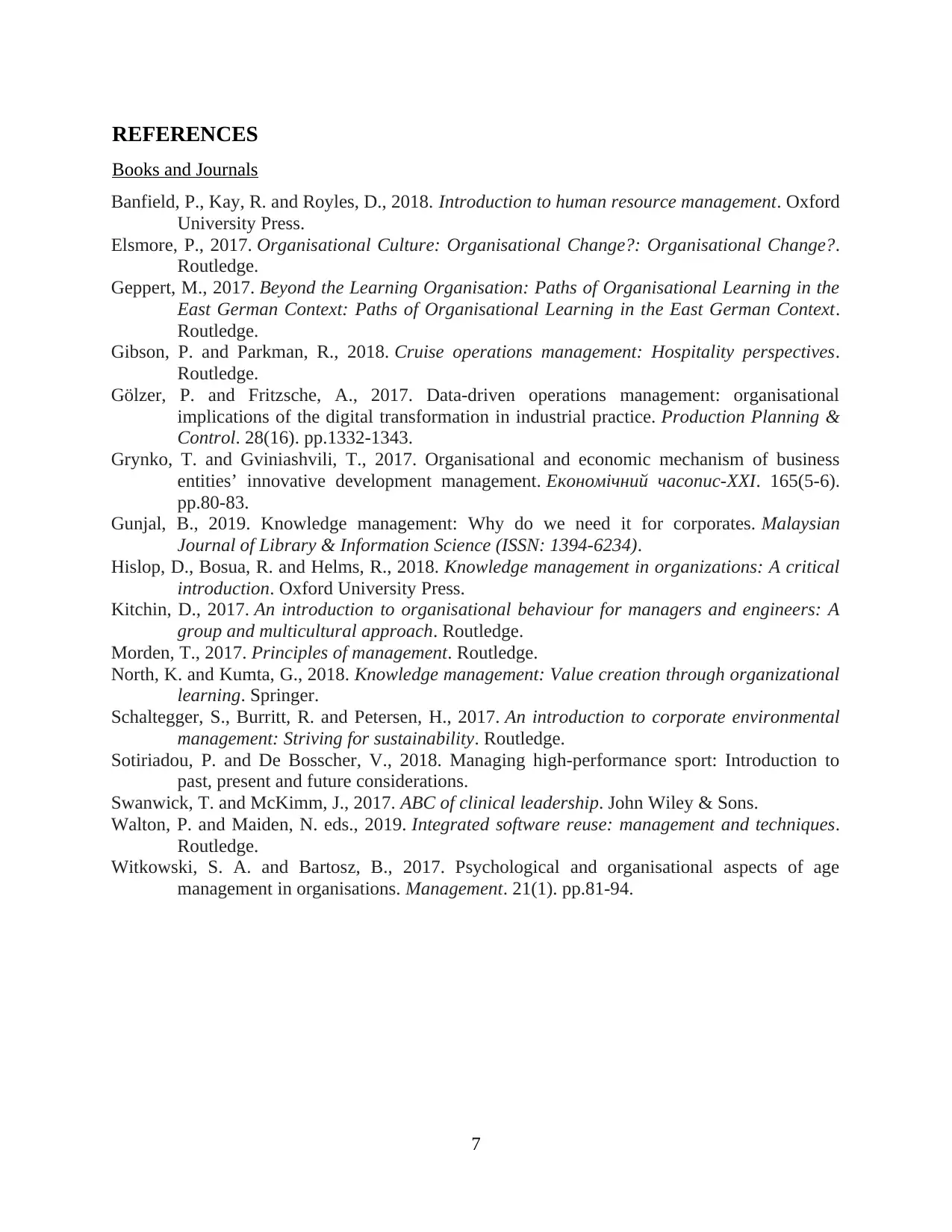
REFERENCES
Books and Journals
Banfield, P., Kay, R. and Royles, D., 2018. Introduction to human resource management. Oxford
University Press.
Elsmore, P., 2017. Organisational Culture: Organisational Change?: Organisational Change?.
Routledge.
Geppert, M., 2017. Beyond the Learning Organisation: Paths of Organisational Learning in the
East German Context: Paths of Organisational Learning in the East German Context.
Routledge.
Gibson, P. and Parkman, R., 2018. Cruise operations management: Hospitality perspectives.
Routledge.
Gölzer, P. and Fritzsche, A., 2017. Data-driven operations management: organisational
implications of the digital transformation in industrial practice. Production Planning &
Control. 28(16). pp.1332-1343.
Grynko, T. and Gviniashvili, T., 2017. Organisational and economic mechanism of business
entities’ innovative development management. Економiчний часопис-XXI. 165(5-6).
pp.80-83.
Gunjal, B., 2019. Knowledge management: Why do we need it for corporates. Malaysian
Journal of Library & Information Science (ISSN: 1394-6234).
Hislop, D., Bosua, R. and Helms, R., 2018. Knowledge management in organizations: A critical
introduction. Oxford University Press.
Kitchin, D., 2017. An introduction to organisational behaviour for managers and engineers: A
group and multicultural approach. Routledge.
Morden, T., 2017. Principles of management. Routledge.
North, K. and Kumta, G., 2018. Knowledge management: Value creation through organizational
learning. Springer.
Schaltegger, S., Burritt, R. and Petersen, H., 2017. An introduction to corporate environmental
management: Striving for sustainability. Routledge.
Sotiriadou, P. and De Bosscher, V., 2018. Managing high-performance sport: Introduction to
past, present and future considerations.
Swanwick, T. and McKimm, J., 2017. ABC of clinical leadership. John Wiley & Sons.
Walton, P. and Maiden, N. eds., 2019. Integrated software reuse: management and techniques.
Routledge.
Witkowski, S. A. and Bartosz, B., 2017. Psychological and organisational aspects of age
management in organisations. Management. 21(1). pp.81-94.
7
Books and Journals
Banfield, P., Kay, R. and Royles, D., 2018. Introduction to human resource management. Oxford
University Press.
Elsmore, P., 2017. Organisational Culture: Organisational Change?: Organisational Change?.
Routledge.
Geppert, M., 2017. Beyond the Learning Organisation: Paths of Organisational Learning in the
East German Context: Paths of Organisational Learning in the East German Context.
Routledge.
Gibson, P. and Parkman, R., 2018. Cruise operations management: Hospitality perspectives.
Routledge.
Gölzer, P. and Fritzsche, A., 2017. Data-driven operations management: organisational
implications of the digital transformation in industrial practice. Production Planning &
Control. 28(16). pp.1332-1343.
Grynko, T. and Gviniashvili, T., 2017. Organisational and economic mechanism of business
entities’ innovative development management. Економiчний часопис-XXI. 165(5-6).
pp.80-83.
Gunjal, B., 2019. Knowledge management: Why do we need it for corporates. Malaysian
Journal of Library & Information Science (ISSN: 1394-6234).
Hislop, D., Bosua, R. and Helms, R., 2018. Knowledge management in organizations: A critical
introduction. Oxford University Press.
Kitchin, D., 2017. An introduction to organisational behaviour for managers and engineers: A
group and multicultural approach. Routledge.
Morden, T., 2017. Principles of management. Routledge.
North, K. and Kumta, G., 2018. Knowledge management: Value creation through organizational
learning. Springer.
Schaltegger, S., Burritt, R. and Petersen, H., 2017. An introduction to corporate environmental
management: Striving for sustainability. Routledge.
Sotiriadou, P. and De Bosscher, V., 2018. Managing high-performance sport: Introduction to
past, present and future considerations.
Swanwick, T. and McKimm, J., 2017. ABC of clinical leadership. John Wiley & Sons.
Walton, P. and Maiden, N. eds., 2019. Integrated software reuse: management and techniques.
Routledge.
Witkowski, S. A. and Bartosz, B., 2017. Psychological and organisational aspects of age
management in organisations. Management. 21(1). pp.81-94.
7
⊘ This is a preview!⊘
Do you want full access?
Subscribe today to unlock all pages.

Trusted by 1+ million students worldwide
1 out of 9
Related Documents
Your All-in-One AI-Powered Toolkit for Academic Success.
+13062052269
info@desklib.com
Available 24*7 on WhatsApp / Email
![[object Object]](/_next/static/media/star-bottom.7253800d.svg)
Unlock your academic potential
Copyright © 2020–2025 A2Z Services. All Rights Reserved. Developed and managed by ZUCOL.




